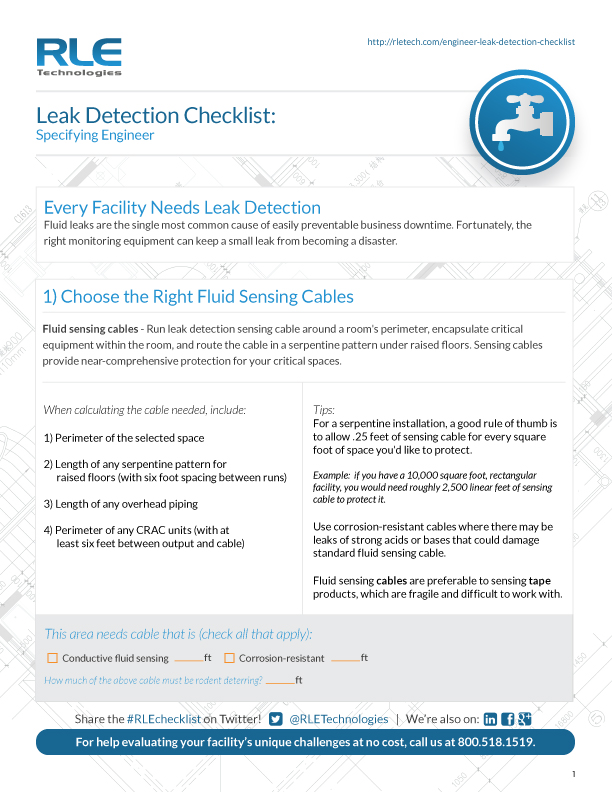A Leak Detection Checklist for Specifying Engineers
A monitoring and detection system as vital as fire or carbon monoxide
Fluid leaks can be devastating for just about any type of business and, unfortunately, they’re very common. On average, most facilities, no matter how well designed and built, will see some kind of leak every two years.
With the high likelihood of occurrence plus the potential for massive losses in time, equipment, and information, the danger of leaks cannot be taken lightly. Guarding against them is as crucial for business operations as detecting fire or carbon monoxide. Fortunately, the right monitoring equipment can keep a small leak from becoming a disaster.
The Leak Detection Checklist for Specifying Engineers walks through the necessary steps to put together the best system for any facility and even builds a Materials List as you go.
(Check out the additional tips below the checklist, too.)
[button link=”http://rletech.com/wp-content/uploads/2014/07/Leak-Detection-Checklist-for-Specifying-Engineers.pdf” class=”btn btn-falcon” text=”Download Our Checklist”]
[button link=”http://rletech.test/wp-content/uploads/2014/07/Leak-Detection-Checklist-for-Specifying-Engineers.pdf” class=”btn btn-falcon” text=”Download Our Checklist”]
Additional Tips
1. Know your facility.
Assembling the correct components is the key to guarding against catastrophe. Start by thinking about what exactly is being protected.
Just about any kind of building or business houses equipment, merchandise, and other assets that could be ruined by a leak:
- Commercial office spaces and server rooms or data centers house high value technology and data. An undetected leak in these areas can also lead to employee downtime and further loss of business, revenue, and reputation.
- A laboratory or research facility is a sensitive environment, holding high value equipment and priceless data.
- Retail spaces carry high value inventory.
- Libraries, museums, and archives store irreplaceable assets.
A leak detection system should be designed with its actual protectees in mind.
2. Research the options.
Once you know what you need, consider the pros and cons of the various models and providers.
A few questions to consider:
- What is this cable’s track record with false alarms?
- Are there remote spaces that need to be integrated wirelessly?
- Does the leak detection system need to communicate with a wider building monitoring system?
- What are the notification capabilities and fail-safes for the system in question?
Have more questions?
Check out our original Leak Detection Checklist for Water and Chemical Risk Mitigation. And don’t hesitate to contact RLE Technologies for a free consultation. We’ve been designing leak detection systems for 30 years and are happy to help you build a customized leak detection system.

